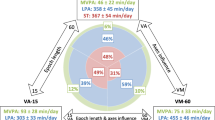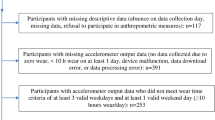Abstract
This study sought to validate cut-points for use of wrist-worn GENEActiv accelerometer data, to analyse preschool children’s (4 to 5 year olds) physical activity (PA) levels via calibration with oxygen consumption values (VO2). This was a laboratory-based calibration study. Twenty-one preschool children, aged 4.7 ± 0.5 years old, completed six activities (ranging from lying supine to running) whilst wearing the GENEActiv accelerometers at two locations (left and right wrist), these being the participants’ non-dominant and dominant wrist, and a Cortex face mask for gas analysis. VO2 data was used for the assessment of criterion validity. Location specific activity intensity cut-points were established via receiver operator characteristic curve (ROC) analysis. The GENEActiv accelerometers, irrespective of their location, accurately discriminated between all PA intensities (sedentary, light, and moderate and above), with the dominant wrist monitor providing a slightly more precise discrimination at light PA and the non-dominant at the sedentary behaviour and moderate and above intensity levels (area under the curve (AUC) for non-dominant = 0.749–0.993, compared to AUC dominant = 0.760–0.988).
Conclusion: This study establishes wrist-worn physical activity cut-points for the GENEActiv accelerometer in preschoolers.
What is Known: • GENEActiv accelerometers have been validated as a PA measurement tool in adolescents and adults. • No study to date has validated the GENEActiv accelerometers in preschoolers. |
What is New: • Cut-points were determined for the wrist-worn GENEActiv accelerometer in preschoolers. • These cut-points can be used in future research to help classify and increase preschoolers’ compliance rates with PA. |
Similar content being viewed by others
Abbreviations
- AUC:
-
Area under the curve
- MET:
-
Metabolic equivalents
- PA:
-
Physical activity
- REE:
-
Resting energy expenditure
- ROC:
-
Receiver operating characteristics
- Se:
-
Sensitivity
- Sp:
-
Specificity
- SPSS:
-
Statistical Package for Social Sciences
- SVMgs:
-
Signal magnitude vector
- VCO2 :
-
Carbon dioxide output
- VO2 :
-
Oxygen consumption
References
Adolph AL, Puyau MR, Vohra FA, Nicklas TA, Zakeri IF, Butte NF (2012) Validation of uniaxal and triaxal accelerometers for the assessment of physical activity in preschool children. J Phys Act Health 9:944–953
Ainsworth BE, Haskell WL, Whitt MC, Irwin ML, Swartz AM, Strath SJ, O’Brien WL, Bassett DR Jr, Schmitz KH, Emplaincourt PO, Jacobs DR Jr, Leon AS (1993) Compendium of physical activities: an update of activity codes and MET intensities. Med Sci Sports Exerc 25:71–80
Bentley GF, Jago R, Turner KM (2015) Mothers’ perceptions of the UK physical activity and sedentary behaviour guidelines for the early years (start active, stay active): a qualitative study. BMJ Open 5:e008383
Cohen J (1988) Statistical power analysis for the behavioral sciences, 2nd edn. Lawrence Earlbaum Associates, Hillsdale
Crouter SE, Flynn JI, Bassett DR Jr (2015) Estimating physical activity in youth using a wrist accelerometer. Med Sci Sports Exerc 47:944–951
Duncan MJ, Wilson S, Tallis J, Eyre E (2016) Validation of the Phillips et al. GENEActiv accelerometer wrist cut-points in children aged 5-8 years old. Eur J Pediatr. doi:10.1007/s00431-016-2795-6
Esliger DW, Tremblay MS (2007) Physical activity and inactivity profiling: the next generation. Can J Public Health 98(Supp 2):S195–S207
Esliger DW, Rowlands AV, Hurst TL, Catt M, Murray P, Eston RG (2011) Validation of GENEA accelerometer. Med Sci Sports Exerc 43:1085–1093
Hardy LL, King L, Kelly B, Farrell L, Howlett S (2010) Munch and move: evaluation of a preschool healthy eating and movement skill program. Int J Behav Nutr Phys Act 7:80
Harrell JS, McMurray RG, Baggett CD, Pennell ML, Pearce PF, Bangdiwala SI (2005) Energy costs of physical activities in children and adolescents. Med Sci Sports Exerc 37:329–336
Jackson DM, Reilly JJ, Kelly LA, Montgomery C, Grant S, Paton JY (2003) Objectively measured physical activity in a representative sample of 3- to 4-year old children. Obes Res 11:420–425
Mackintosh KA, Ridley K, Stratton G, Ridger ND (2016) Energy cost of free-play activities in 10-to 11-year-old children. J Phys Act Health 13(Supp):S71–S74
McArdle WD, Katch FI, Katch VL (2010) Exercise physiology: nutrition, energy, and human performance, 7th edn. Lippincott Williams & Wilkins, Philadelphia
Pate RR, O’Neill JR, Lobelo F (2008) The evolving definition of “sedentary”. Exerc Sport Sci Rev 36(4):173–178
Pepe M, Janes H, Longton G, Leisenring W, Newcomb P (2004) Limitations of the odds ratio in gauging the performance of a diagnostic, prognostic, or screening marker. Am J Epidemiol 159:882–890
Phillips LRS, Parfitt G, Rowlands AV (2014) Calibration of the GENEA accelerometer for assessment of physical activity intensity in children. J Sci Med Sport 16:124–128
Reilly JJ, Janssen X, Cliff DP, Oakley AD (2015) Appropriateness of the definition of ‘sedentary’ in young children: whole-room calorimetry study. J Sci Med Sport 18:565–568
Ridley K, Olds TS (2008) Assigning energy costs to activities in children: a review and synthesis. Med Sci Sports Exerc 40:1439–1446
Rose-Jacobs R (1983) Development of gait at slow, free, and fast speeds in 3- and 5-year old children. Phys Ther 63:1251–1259
Saint-Maurice PF, Kim Y, Welk GJ, Gaesser G (2016) Kids are not little adults: what MET threshold captures sedentary behavior in children? Eur J Appl Physiol 116:29–38
Sallis JF, Buono MJ, Freedson PS (1991) Bias in estimating caloric expenditure from physical activity in children. Implications for epidemiological studies. Sports Med 11:203–209
Schofield WN (1985) Predicting basal metabolic rate, new standards and review of previous work. Hum Nutr Clin Nutr 39(Suppl 1):5–41
Spurr GB, Barac-Nieto M, Reins JC, Ramierez R (1984) Marginal mal-nutrition in school-aged Colombian boys: efficiency of treadmill walking in submaximal exercise. Am J Clin Nutr 39:452–459
Vale S, Trost SG, Duncan MJ, Mota J (2015) Step based physical activity guidelines for preschool-aged children. Prev Med 70:78–82
Welk GJ (2005) Principles of design and analyses for the calibration of accelerometry-based activity monitors. Med Sci Sports Exerc 37(Suppl. 11):S501–S511
Westerterp KR (1999) Physical activity assessment with accelerometers. Int J Obes Relat Metab Disord 23(Supp 3):S45–S49
Author information
Authors and Affiliations
Contributions
Clare Roscoe—conception and design of the study, data acquisition (patients’ measurements), analysis of the data, preparation of the tables, preparation of the manuscript, finding relevant references and final approval of the manuscript.
Michael Duncan—conception and design of the study, analysis of the data, preparation of the tables, preparation of the manuscript, finding relevant references and final approval of the manuscript.
Rob James—analysis of the data, preparation of tables and charts, preparation of the manuscript, finding relevant references and final approval of the manuscript.
Corresponding author
Ethics declarations
Funding
None do declare.
Ethical approval
All procedures performed in the studies involving human participants were in accordance with the ethical standards of the institutional research committee and with the 1964 Helsinki declaration and its later amendments or comparable ethical standards.
Conflict of interest
The authors declare that they have no conflict of interest.
Additional information
Communicated by Mario Bianchetti
Rights and permissions
About this article
Cite this article
Roscoe, C.M.P., James, R.S. & Duncan, M.J. Calibration of GENEActiv accelerometer wrist cut-points for the assessment of physical activity intensity of preschool aged children. Eur J Pediatr 176, 1093–1098 (2017). https://doi.org/10.1007/s00431-017-2948-2
Received:
Accepted:
Published:
Issue Date:
DOI: https://doi.org/10.1007/s00431-017-2948-2




